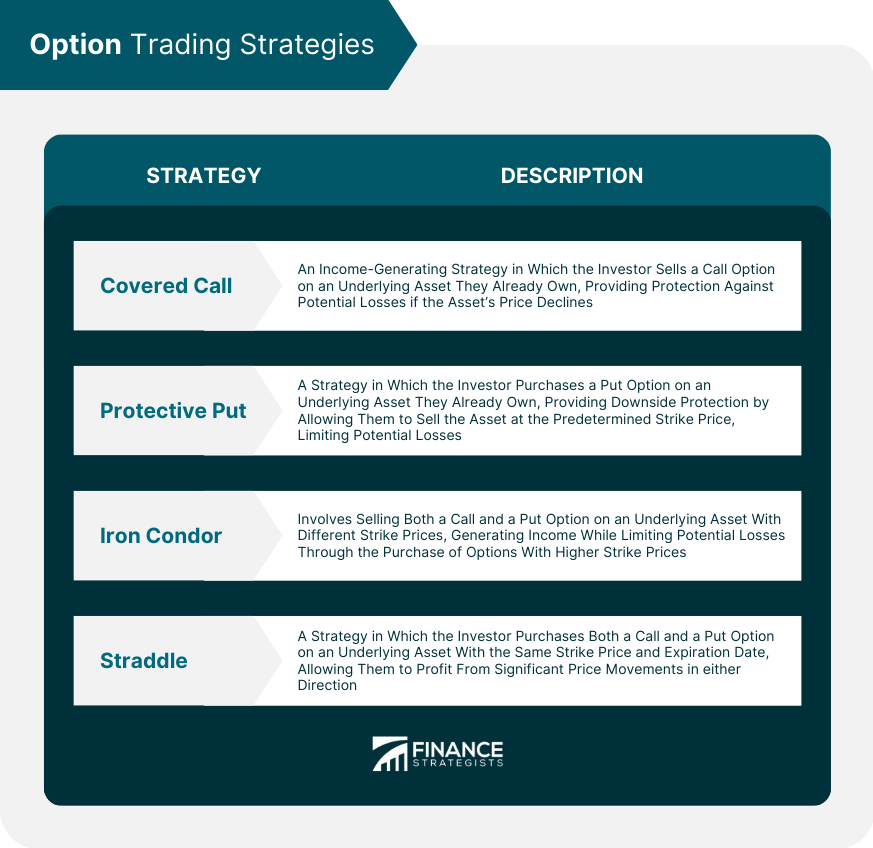Options are financial contracts that provide the right, but not the obligation, to buy or sell an underlying asset at a predetermined price and time. Options trading allows investors to profit from market fluctuations and manage risk in their investment portfolios. Options are commonly used to speculate on future price movements, hedge against potential losses, or generate additional income through trading strategies. Options play a crucial role in modern finance by providing investors with a range of investment opportunities and risk management tools. Options trading enables investors to leverage their capital, protect their portfolios against potential losses, and generate additional income through trading strategies. Options can be used to speculate on the future price movements of underlying assets, hedge against market volatility, or generate income through covered call or protective put strategies. A call option gives the buyer the right, but not the obligation, to buy an underlying asset at a predetermined price and time. Call options are typically used by investors who expect the price of the underlying asset to increase. When a call option is exercised, the buyer can purchase the underlying asset at the strike price and sell it at a higher market price to realize a profit. If the price of the underlying asset remains below the strike price, the buyer can choose not to exercise the option and let it expire worthless. A put option gives the buyer the right, but not the obligation, to sell an underlying asset at a predetermined price and time. Put options are commonly used by investors who expect the price of the underlying asset to decrease. When a put option is exercised, the buyer can sell the underlying asset at the strike price and buy it back at a lower market price to realize a profit. If the price of the underlying asset remains above the strike price, the buyer can choose not to exercise the option and let it expire worthless. A covered call is a trading strategy in which the investor sells a call option on an underlying asset that they already own. The covered call strategy generates income by selling the call option while also protecting against potential losses if the underlying asset's price declines. If the price of the underlying asset increases, the call option may be exercised, and the investor may sell the asset at the predetermined strike price to realize a profit. If the price of the underlying asset declines, the investor keeps the premium received from selling the call option and maintains ownership of the underlying asset. A protective put is a trading strategy in which the investor purchases a put option on an underlying asset that they already own. The protective put strategy provides downside protection by allowing the investor to sell the underlying asset at the predetermined strike price, limiting potential losses. If the price of the underlying asset declines, the investor can exercise the put option and sell the asset at the predetermined strike price, realizing a profit. If the price of the underlying asset increases, the investor can choose not to exercise the option and let it expire worthless while maintaining ownership of the asset. An iron condor is a trading strategy that involves selling both a call and a put option on an underlying asset with different strike prices. The iron condor strategy generates income through the sale of the call and put options while limiting potential losses through the purchase of options with higher strike prices. If the price of the underlying asset remains within the range of strike prices, the iron condor strategy generates a profit. If the price of the underlying asset moves outside the range of strike prices, the strategy may result in losses. A straddle is a trading strategy that involves purchasing both a call and a put option on an underlying asset with the same strike price and expiration date. The straddle strategy allows investors to profit from significant price movements in either direction, regardless of whether the price of the underlying asset increases or decreases. If the price of the underlying asset increases, the call option may be exercised, and the investor can sell the asset at the predetermined strike price to realize a profit. If the price of the underlying asset decreases, the put option may be exercised, and the investor can sell the asset at the predetermined strike price to realize a profit. The price of the underlying asset is one of the primary factors that influence option prices. The higher the price of the underlying asset, the more valuable the call option, and the less valuable the put option. Changes in the price of the underlying asset can significantly impact the value of options. Investors must monitor the price of the underlying asset closely to make informed trading decisions. The time to expiration is another critical factor that influences option prices. As the expiration date approaches, the time value of the option decreases, leading to a reduction in the option's overall value. Investors must consider the time to expiration when developing trading strategies and making investment decisions. Options with longer expiration dates may provide greater flexibility but may also carry additional risk. Volatility measures the degree of fluctuation in the price of the underlying asset. High volatility increases the value of options by increasing the likelihood of significant price movements. Investors must consider the volatility of the underlying asset when trading options. High volatility may provide greater profit potential but may also increase the potential for losses. Interest rates can impact the value of options by influencing the cost of borrowing money to purchase underlying assets. Higher interest rates increase the cost of borrowing, reducing the overall value of options. Investors must consider the prevailing interest rates when trading options. Changes in interest rates may impact the value of options and influence investment decisions. The Black-Scholes model is a widely used option pricing model that uses mathematical formulas to estimate the fair value of options. The model considers several factors, including the underlying asset price, time to expiration, volatility, interest rates, and strike price. The Black-Scholes model provides investors with an estimate of the fair value of options, enabling them to make informed investment decisions. However, the model has limitations and may not accurately reflect the actual market price of options. The binomial option pricing model is a mathematical model that uses a binomial tree to estimate the fair value of options. The model considers several factors, including the underlying asset price, time to expiration, volatility, and strike price. The binomial option pricing model provides investors with an estimate of the fair value of options that can be customized to reflect specific market conditions. The model is more flexible than the Black-Scholes model but may be more time-consuming to use. Monte Carlo simulation is a method used to estimate the fair value of options by simulating a large number of possible outcomes based on various factors, including the underlying asset price, time to expiration, volatility, and interest rates. Monte Carlo simulation provides investors with a range of potential outcomes and helps them make informed investment decisions. The method can be time-consuming but may provide more accurate estimates of the fair value of options. Market risk is the potential for financial loss due to changes in market conditions, including changes in the price of the underlying asset, volatility, and interest rates. Options trading carries significant market risk and may result in substantial losses. Investors must understand the potential market risks associated with options trading and develop appropriate risk management strategies. Counterparty risk is the potential for financial loss due to the failure of a counterparty to fulfill their contractual obligations. Options trading involves counterparties, including brokers and other traders, who may fail to fulfill their obligations. Investors must understand the potential counterparty risks associated with options trading and work with reputable brokers and counterparties to minimize potential losses. Liquidity risk is the potential for financial loss due to the inability to buy or sell options quickly at a fair price. Options trading may be less liquid than other financial markets, and investors may have difficulty selling options quickly in volatile market conditions. Investors must understand the potential liquidity risks associated with options trading and develop appropriate risk management strategies. The Securities and Exchange Commission (SEC) is a government agency that regulates the securities markets, including options trading. The SEC oversees the registration and activities of brokers and dealers involved in options trading and enforces securities laws and regulations. Investors must comply with SEC regulations when trading options and work with registered brokers and dealers. The Financial Industry Regulatory Authority (FINRA) is a self-regulatory organization that oversees the activities of securities firms involved in options trading. FINRA establishes and enforces rules and regulations designed to protect investors and maintain fair and efficient markets. Investors must comply with FINRA regulations when trading options and work with registered securities firms. The Options Clearing Corporation (OCC) is a clearinghouse that guarantees options contracts and ensures the performance of contractual obligations. The OCC manages risk in the options markets by monitoring market activity and ensuring that counterparties fulfill their obligations. Investors must work with registered clearing members of the OCC to ensure the proper settlement of options contracts. Options play a crucial role in modern finance by providing investors with a range of investment opportunities and risk management tools. Options trading allows investors to leverage their capital, protect their portfolios against potential losses, and generate additional income through trading strategies. Investors must understand the risks and opportunities associated with options trading and develop appropriate risk management strategies. The options markets continue to evolve, with new technologies and market structures emerging. The continued growth of electronic trading platforms and the use of artificial intelligence and machine learning in option pricing models are likely to impact the options markets in the future. Investors must stay informed about emerging trends and developments in options trading and adapt their strategies accordingly to stay competitive in the markets.Definition of Options
Types of Options
Call Options
Put Options

Option Trading Strategies
Covered Call
Protective Put
Iron Condor
Straddle

Factors Influencing Option Prices
Underlying Asset Price
Time to Expiration
Volatility
Interest Rates
Option Pricing Models
Black-Scholes Model
Binomial Option Pricing Model
Monte Carlo Simulation
Risks Associated With Options Trading
Market Risk
Counterparty Risk
Liquidity Risk
Regulation and Compliance in Options Trading
Securities and Exchange Commission (SEC)
Financial Industry Regulatory Authority (FINRA)
Options Clearing Corporation (OCC)
Conclusion
Options FAQs
Options are contracts that give the owner the right, but not the obligation, to buy or sell an underlying asset at a predetermined price.
The two main types of options are call options, which give the owner the right to buy an underlying asset, and put options, which give the owner the right to sell an underlying asset.
The price of an option is determined by various factors, including the current price of the underlying asset, the strike price, the time until expiration, and market volatility.
Some popular options trading strategies include covered calls, protective puts, straddles, strangles, and iron condors.
Options trading carries a high degree of risk, as the potential for loss can be significant. Common risks include market risk, volatility risk, and liquidity risk, among others. It's important to understand these risks before engaging in options trading.
True Tamplin is a published author, public speaker, CEO of UpDigital, and founder of Finance Strategists.
True is a Certified Educator in Personal Finance (CEPF®), author of The Handy Financial Ratios Guide, a member of the Society for Advancing Business Editing and Writing, contributes to his financial education site, Finance Strategists, and has spoken to various financial communities such as the CFA Institute, as well as university students like his Alma mater, Biola University, where he received a bachelor of science in business and data analytics.
To learn more about True, visit his personal website or view his author profiles on Amazon, Nasdaq and Forbes.















